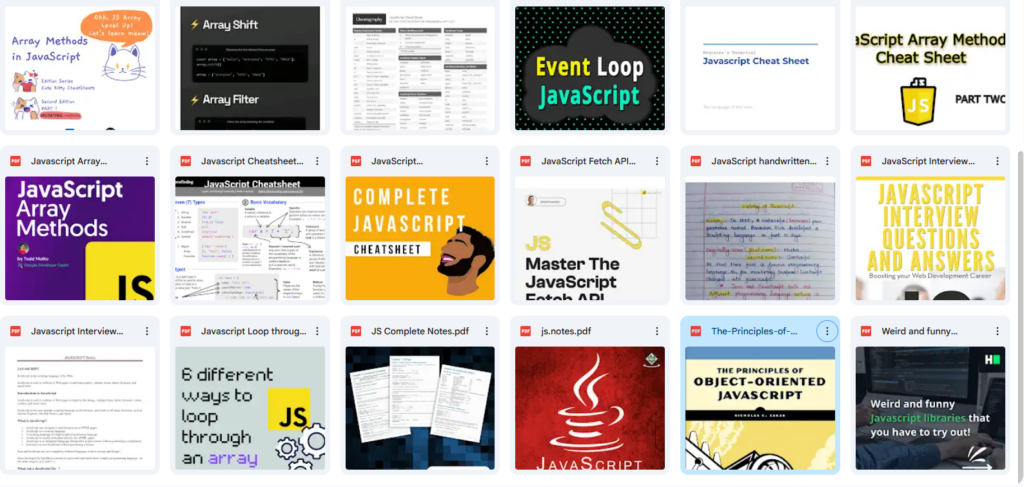
JavaScript Handwritten Notes, Cheat Sheets, and Interview Preparation Guide
JavaScript is the most essential language for web development. It powers interactive websites, forms the base for frameworks like React, Vue, and Angular, and even runs backend applications with Node.js.
This complete guide helps you learn JavaScript step by step — with a learning roadmap, YouTube playlists, and direct links to notes, cheat sheets, and interview questions.
Introduction to JavaScript
JavaScript (JS) is a high-level, dynamic programming language that allows developers to make web pages interactive and functional. It supports multiple paradigms including object-oriented and functional programming.
Why Learn JavaScript
- Fundamental for frontend development
- Extends to backend via Node.js
- Powers interactive and dynamic web apps
- Required skill for React, Next.js, and other modern frameworks
- Highly in-demand in web and full-stack development roles
Recommended YouTube Playlists
- JavaScript Full Course for Beginners – freeCodeCamp
- Namaste JavaScript – Akshay Saini
- Traversy Media JavaScript Tutorials
- Frontend Masters JavaScript Channel
JavaScript Learning Roadmap
Before diving into notes and interview questions, here’s a clear learning path to follow.
This roadmap will help you progress logically from beginner to advanced level.
Step 1: Basics of JavaScript
- Introduction to JavaScript
- Variables (
let,const,var) - Data types (String, Number, Boolean, Null, Undefined, Symbol)
- Operators and Expressions
- Conditional statements (
if,else,switch) - Loops (
for,while,do-while)
Goal: Understand how JavaScript syntax and logic flow work.
Step 2: Functions and Scope
- Function declarations and expressions
- Arrow functions
- Parameters, return values
- Scope (local, global, block)
- Hoisting and the execution context
- Closures
Goal: Write reusable code and understand how memory and variables behave.
Step 3: DOM and Events
- Understanding the Document Object Model
- Selecting and manipulating elements (
querySelector,getElementById) - Event listeners and handling user interactions
- Browser APIs and timers
Goal: Build dynamic, interactive web pages.
Step 4: Arrays, Objects, and Built-in Methods
- Creating and modifying arrays and objects
- Common array methods (
map,filter,reduce,forEach) - Object destructuring and spread operators
- JSON parsing and stringifying
Goal: Work efficiently with collections of data.
Step 5: Advanced JavaScript Concepts
- Prototypes and Inheritance
thiskeyword and binding- Event loop, call stack, and microtasks
- Promises and async/await
- Error handling and debugging
Goal: Gain a deep understanding of how JavaScript executes code asynchronously.
Step 6: Object-Oriented JavaScript
- Classes and constructors
- Inheritance and encapsulation
- Modules and imports/exports
Goal: Write modular and structured code.
Step 7: JavaScript and APIs
- Fetch API and AJAX
- REST APIs and JSON handling
- Asynchronous data fetching
Goal: Learn how JavaScript connects to external data and services.
Step 8: Modern JavaScript (ES6+)
- Template literals
- Arrow functions
- Destructuring
- Default parameters
- Modules and imports
- Async/Await
Goal: Stay up-to-date with modern JavaScript syntax and features.
Step 9: Projects and Practice
- Build a to-do list
- Create a weather app using API
- Develop a quiz application
- Work with DOM and storage APIs
Goal: Apply what you’ve learned in real-world scenarios.
Step 10: Interview and Optimization
- Solve JavaScript-based DSA problems
- Understand performance optimization
- Prepare with 400+ interview questions below
JavaScript Notes, Cheat Sheets, and Interview Resources

- JavaScript Handwritten Notes (PDF)
- JavaScript Cheatsheet
- 400 JavaScript Interview Questions
- JavaScript Interview Questions and Answers
- Advanced JavaScript Notes
- Array Methods in JavaScript
- Event Loop in JavaScript
- OOPs in JavaScript
- API Notes
- JavaScript Notes for Professionals
- JavaScript TutorialsPoint Notes
How to Study Effectively
- Start with YouTube playlists for conceptual understanding.
- Follow the roadmap step by step.
- Use handwritten notes for revision.
- Refer to the cheatsheet during practice.
- Prepare for interviews using the 400+ question set.
At last!
JavaScript is the foundation of web development and one of the most powerful languages to learn in your tech journey. This roadmap and resource collection will help you master it from scratch to professional level.
Keep learning, building, and exploring — consistency is the key to mastering JavaScript.
Join Telegram group for more resources & discussions!
🧰 Useful Resources for Your Placement Prep
Lets Code
Contributing Writer